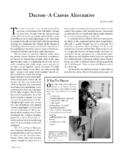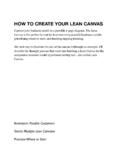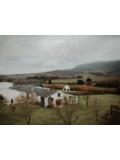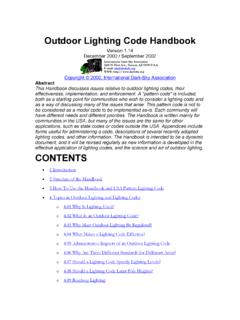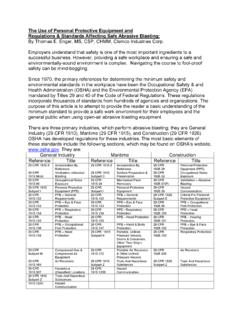Transcription of Wooden Canoe - Stewart River Boatworks
1 Courses, Classes, Early Summer WCHA Annual ReportBuilding a One-Off Wood & Canvas CanoeRay Arcand: A Living Link to the PastWooden CanoeIssue 134, April 2006 Volume 29, No. 24 Wooden CanoeA few years ago, I received a call requesting a custom Canoe . Since there is a considerable expense in constructing the solid form for what would likely be a one-off production, I was not initially very recep-tive. With an evening to mull it over, however, I began to consider an alternative to the time-consuming solid form customarily used to build a wood and canvas canoes. Several years earlier, I had glanced at a 1938 article published in Popular Mechanics about building a rib-and-plank-style Canoe with a form that was much simpler than the solid form used by production Canoe builders.* My impressions from that article were that the method seemed a bit cumbersome, so on a second evening I began to think through a new open form construction long and short of it is that I built the Canoe for this project and liked it so much I went on to build one for myself.
2 With this second version, however, I changed the sheer line and stem pro-file. That absolutely thrilled me the form could be easily modified in such a way that it totally changed the appearance of the Canoe . I quickly realized I could just as easily change the length of the boat simply by increasing or condensing the space between station molds. The real thrill, however, was when I looked up to see the form for this Canoe hanging on nails driven into the wall, while my eight stock model forms fairly well filled a large shed attached to my boat building I had begun by looking for a way to build a one-off Canoe , I ended up discovering a process that could be used as an important tool for Canoe design. Building the Form I begin the construction of the form the same way I would if I were building a solid form. The major differ-ence is that instead of completely sheathing the station molds, as is done in constructing a solid form, I use horizontal ribbands spaced three to four inches apart (Figure 1).
3 With some changes in the technique for bending ribs, these bands pro-vide sufficient support for steam bending the ribs. I start by setting up a building platform that is straight and level. I make it Building a One-Off Wood & Canvas Canoeby Alex CombOff the form! Alex Comb removes a new Canoe from a rather spare form. If you want a form that takes up a fraction of the space of a normal form, read 1. Screwing the ribbands to the last station. *Twenty-five years ago, Jack Davis s article, Building the Popular Mechanics Canoe appeared in Wooden Canoe (Issue 7, Summer 1981). The article is available at Editor Issue 134 April 2006 5from two 2x6s that are sawed straight and set on edge with pieces of 16-inch wide 1/4-inch plywood nailed to the top edge for the length of the 2 x 6s. A center line is snapped down the length of the platform, and station section lines are drawn at right angles to the center line.
4 I screw 2x2s to one side of each of these section lines. Three-quarter-inch plywood station molds are then screwed to the 2x2s. With the station molds secured to the platform, the stem backer molds are fi tted to the last station molds and sited true before being screwed in place through the last station and through the platform bed s 1/4-inch plywood. I also fi nd it helpful to install a keel backer into slots I have cut in each station mold. The keel backer is made of 1x4, which I lay out on the bench, and I transfer the keel line by plotting points for each station. I then saw the 1x4 to the line I have plotted and use the keel backer to bring all the station molds into proper justifi cation at the keel. Once the station molds appear to be set up straight and true on the building platform, I install the gunwale backer in the notches previously cut into the station molds. (This gunwale backer is visible in the introductory photograph on page 4.)
5 For this I use a hardwood with few imperfections since the backer will end up being the guide for the inwale and will describe the sheer line of the fi nished boat. I often make up the backer of shorter pieces, scarf jointed together. (A scarf joint is made by cutting matching tapers into the ends of the pieces to be joined. The taper should be about twelve times longer than it is wide to make a good glue joint.) I screw the backer pieces at each station mold through pre-drilled and counter-bored pilot holes so that the screw heads are counter sunk and will not touch the inwale when it is clamped to the backer. Blocks may also be screwed to the stem molds to hold the inwales in place at the ends. (The blocks are visible in Figure 7.)The horizontal ribbands should run full length, from stem mold to stem mold, and screwed to the last station mold. (See Figure 1.) I make the ribbands of ash because it bends well and is strong enough to span the 16 inches between sta-tions.
6 These strips of wood should be to the dimension your plans call for (on my plans they are 9/16 inch thick). They should be made from good straight-grained material and made up of shorter pieces scarf-joined together if full length stock is unavailable. The spacing of the ribbands will vary with location, being closest together at the bilges where the curve of the hull is tightest. The ribbands will be taken off the form after the ribs are bent and before the planking is applied, so the fasten-ings need to be removed easily. To attach the ribbands to the molds, I choose plastic electrical banding. It is readily available, inexpensive, and easy to use. In the areas where this proves not strong enough to withstand the stresses of bending and twisting, I resort to steel wire. Once the rib-band locations are laid out on the form, I drill a 1/4-inch hole through the plywood station mold beneath each rib-band intersection.
7 The ribband is notched diagonally at each station with a round rasp to accept the electrical tie so that it can be tied to the station mold with the electrical tie countersunk below the surface of the ribband, or it can be threaded through a hole drilled through the ribband at this location. (See detail in Figure 2.) With all the ribbands in place, their outer edges should be knocked down by using a sanding board or rasp. This will help prevent the ribs from being crimped as they are bent over the ribbands. Steam Bending the RibsAt this point, I lay out the path of the steam-bent ribs. First, I mark on the keel ribband, which runs from stem to stem down the middle of the Canoe , the location of the center rib. This is centered on the center station mold at the Canoe s midships. From the edges of this rib, I mark off a consistent spacing (usually 31/2 to 4 inches from one edge to the same edge of the next rib) for all the remaining ribs.
8 Because of the changing shape of a Canoe being narrower in the ends than at midships the ribs will tend to cock back toward the midships as they are bent over the form. To find this natural path, I take a strip of sheet metal or flexible Figure 2. Steam bending a rib in place. Note plastic electrical ties that are used to hold the ribbands to the stations. (See detail above.) 6 Wooden Canoeplastic, cut to the width of the rib, and lay it across the form at each rib location. The piece of metal or plastic will naturally follow the path the rib wants to take. Check it from one side to the other side and adjust the spacing at the inwale so that it is the same on both sides, and for the corresponding rib on the other end of the ribs are made of northern white cedar (Thuja occidentalis) planed to 1/4-inch thickness, and tapering from 21/4-inches wide at the center to 11/4-inches at the ends.
9 A finished edge can be applied to the ribs with a 1/2-inch radius router bit. The prepared ribs are soaked several days before they are steam-bent. The amount of time needed to steam the ribs will depend on how hot the steam is and how much steam is routed to the steam box. These thin ribs should bend very easily, though some care will be needed to avoid crimping them over the rib-bands. I find that it s possible to bend the ribs above the ribbands by placing a gloved hand underneath the rib as I am bending, rather than forcing the rib down directly on the ribbands. Another method that has worked well is to slip a thin plastic band under the rib being bent to give some support between ribbands. (The plastic will help the rib make a fair curve between the ribbands and can be removed once the rib is bent.) Each bent rib can be held in place with spring clamps at the inwales (Figure 2), checked for conformance to the form, and then nailed to the inwale with two bronze ring-shank nails.
10 With all the ribs bent and fastened in place, I let them dry overnight before checking for final fairness and planning or sanding any high spots (Figure 3). Once I ve checked for fairness using a thin batten and am satisfied all is true, I seal the back sides of the ribs to prevent water Figure 4. To clench the tacks, an iron is held under each when the Canoe is in use. The planking, which is normally 3 inches wide and 5/32-inch thick, is finished similarly, so that the surfaces under each rib are sealed against moisture intrusion. Planking the CanoeFor planking stock, I normally use white cedar as well, selecting the vertical grain (as close to quarter sawn as possible) pieces for the bottom areas of the boat and the bilges. Vertical grain stock is stiffer and more stable than flat sawn stock, and it usually bends more the planking sanded on one side and sealed, it can now be fastened to the ribs with sharp brass Canoe tacks driven through the planking and ribs and clenched by an iron held directly under the rib (Figure 4).
